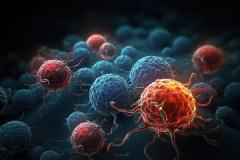
Understanding Myelofibrosis: Disease Spectrum and Impact on Quality of Life
Aaron Gerds, MD, MS, compares myelofibrosis with other myeloproliferative neoplasms, explores its prevalence in the US, and reviews the diverse clinical presentations and the impact on patients’ quality of life.
Episodes in this series

This is a video synopsis/summary of a Guidelines featuring Aaron Gerds, MD, MS.
Gerds sheds light on myelofibrosis (MF), a clonal myeloid disorder categorized under myeloproliferative neoplasms. He draws comparisons between MF, polycythemia vera (PV), and essential thrombocythemia (ET), emphasizing the shared pathobiologic factor of constitutive activation of the JAK-STAT pathway. MF clinically manifests with diverse symptoms, including elevated blood counts, constitutional symptoms like night sweats and weight loss, and splenomegaly, affecting the patient's quality of life significantly.
Gerds discusses the prevalence of MF, estimating approximately 300,000 people in the United States living with myeloproliferative neoplasms. He notes that while MF may have a higher incidence, the shortened life expectancy compared with PV and ET results in lower prevalence. The clinical presentation of MF varies, often diagnosed through routine blood work, symptom manifestation, or as a progression from ET or PV.
Exploring the burdens of MF, Gerds addresses cytokine-mediated symptoms, anemia challenges, and the overarching impact of having a chronic illness. Anemia, affecting around 40% of patients at diagnosis, presents a significant burden on patients' lives, particularly when transfusion-dependent. Furthermore, the chronic nature of MF, unless treated with stem cell transplant, adds an emotional burden often underrepresented in disease analyses. The conversation provides a comprehensive understanding of MF and its multifaceted effects on patients.
Video synopsis is AI-generated and reviewed by AJMC® editorial staff.
Newsletter
Stay ahead of policy, cost, and value—subscribe to AJMC for expert insights at the intersection of clinical care and health economics.









































